
|
January 9th 2008
The Historical French Influence on
the American Automotive Landscape
By Philippe H. Defechereux © 2008
Our title will probably surprise most readers, prompting the immediate question: “What French influence?” Almost two decades ago, Peugeot and Renault, the last two French car manufacturers left standing today in Europe, found themselves without customers in America and went home in defeat. The French, who practically invented the automobile, are thus the only people of the industrial world who could not hack it in the planet’s biggest and richest market. The Germans, the Japanese, the Koreans, the Swedes, even the Italians and the Brits all have a viable presence here, but the French are gone. Not only is this a defeat, it’s a feat in itself!
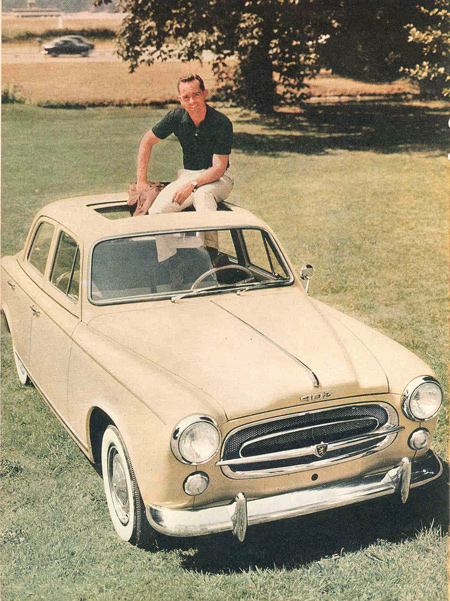
This is the left side of a double-page spread ad where Phil Hill proclaimed the Peugeot 403 as his favorite car for driving around Europe “between races.” He extolled the car’s safety, roominess, comfort and outstanding road-handling. All true and actually a very good ad. It did not help as the 403’s sent to the U.S. were in no way modified for American driving habits and conditions.
|
Ah, but that’s only the surface of things. Renault took a majority share in Nissan a few years back, a Japanese company then considered a basket case. Carlos Ghosn was put in charge of turning it around. He achieved the impossible and is now the Head of both Renault and Nissan; the latter is a healthy marque in the U.S. today. So follow this pied piper. Give the French some deserved automotive credit by reaching into the past, something they always love to do. Their influence here was profound and multi-faceted indeed; it still haunts our present wheeled existence in ways we Americans surely do not readily remember or are even aware of. Let us, then, illuminate this long-forgotten French connection and turn it into a fast and exciting car chase down the twisted highway of history.
It all started, believe it or not, in 1699 in the Great Lakes region. That’s when and where an ambitious immigrant from Gascony, a French province north of the Pyrenees, was named Colonial Governor of “La Nouvelle France” by King Louis XIV, and was granted his request for land and trade privileges on the narrow stretch of territory that separates Lake Erie from Lake St. Clair, leading to Lake Huron. The brilliant young Frenchman had judged that spot to be the best strategic position for building a key fort: the one meant to defend access to the western Great Lakes and the Mississippi valley against the hated British colonies to the east.
His name was Antoine de la Mothe Cadillac. He had the fort built forthrightly while also inspiring new immigrants and local Indian tribes to build a town around it. By 1701, Cadillac was ready to inaugurate the new city. He named it “Détroit,” which is the French word for ‘straits’ (as in the Straits of Gibraltar), reflecting the river that cuts across the land bridge between Lake Erie and Lake Huron. As a final word, so to speak, Monsieur Antoine was a Baron, so one would have addressed him in those days as Monsieur Le Baron.
So that’s how the preliminary stage was set. Almost 200 years before the car was invented, a Frenchman had already contributed a key location and three names, which later the American car industry would adopt and make world famous. So one must concede: not bad for a Frenchman new to the New World and who most certainly never imagined that carriages one day would be both horseless and self-propelled. In the late 19th century, Cadillac’s compatriots were the first to coin a good word in their language for the ungainly expression “self-propelled.” They came up with automobile, combining two Latin root words. The French indeed can take the credit for its creation and eventual universal adoption to designate the new, revolutionary invention.
Though Karl Benz of Germany is himself credited for the invention of the first automobile in 1885, his first “horseless carriage” was an awkward tricycle powered by a single-cylinder engine. It is really the French, principally René Panhard and Emile Levassor, but also Louis and Marcel Renault, Count Albert de Dion and Armand Peugeot, who gave the automobile its modern form – engine in front, followed by transmission of power to rear wheels by means of a longitudinal axle – and developed the suspension designs, gearboxes, steering and braking systems that made the modern car possible.
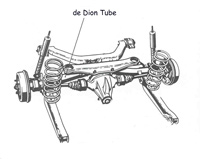
An independent rear axle with a de Dion tube.
|
As a result of that early leadership, The de Dion rear axle and Pan hard rod are lasting technological inventions bearing the name of their French inventors.
Most publicly visible, certain basic car types to this day universally take their name from French towns or words. For example the limousine, that ultra-favorite of modern celebrities, is the French word for a female inhabitant of the town of Limoges, also celebrated for its porcelain. A sedan, generally describing a four-door passenger car, evolved in the northern French town of Sedan, ironically also famous for two crushing French military defeats (1870 and 1940). When a sedan is reduced in length to turn up a sporty two-door version, the new car is called a coupé, the French word for ‘cut’ (past participle). The convertible version of a coupé is called cabriolet, based on the French name of a female hat opened at the front. Finally, in an ironic twist, G.M.’s Cadillac brand called one of its most famous post WWII model de Ville, which is French for "urbanite," meaning no country folks can afford such a car. The ultimate nod given by Detroit to the French, then was the Cadillac Sedan DeVille.
During that energetic last decade of the 19th century, the French also invented motor racing by staging the first "course" automobile ever in June of 1894 ("course" in French means "race" as in car race). It was staged between Paris and Rouen, a 32-mile course. A Peugeot and a Levassor were declared co-winners. The public enthusiasm generated by seeing the revolutionary new invention compete on open roads was such that racing spread throughout Europe and America like a flash fire, never to be stopped. As early as 1905, the Automobile Club de France (ACF) brought car racing to a new level by creating the concept of the international Grand Prix (French for ‘grand prize’), represented by a very large sum of money, in this case 100,000 francs. The 1906 Grand Prix was staged on a circuit made up of 64 miles of closed public roads near the town of Le Mans, southwest of Paris. The race was won by a Renault, followed by a Fiat, and those two makes are still battling it out today in Formula 1.
As all of this was happening in Europe, the early American pioneers such as Charles Duryea, Henry Ford, David Buick and Ransom Olds were just getting their feet wet and mostly learning and licensing from across the Atlantic. In 1910 three brothers, Arthur, Louis and Gaston, with the surname Chevrolet, opened for business in the fast-bubbling new car industry in Detroit. They actually were born in a French canton of Switzerland and had lived in France many years before emigrating to Canada, then Michigan. Their young company, like many others, was soon absorbed into a bigger one. Within a decade, the names Cadillac and Chevrolet were pegged into the General Motors “income ladder” system of branding, famously created by Billy Durant, G.M.’s founder. Conspicuously, the noble Cadillac moniker took the top of the ladder and the modest Chevrolet tag became the entry badge. Baron Antoine would have approved.
Meanwhile, French cars were praised by teams and drivers whose goal was to win the famed Indy 500, the most prestigious race in America. And win they did: Peugeots in 1913 (Jules Goux), 1916 (Dario Resta) and 1919 (Howdy Wilcox) then a Delage in 1914 (René Thomas). But after that, the Duesenbergs and Millers took over on the famed oval, and the French were never to contest again.
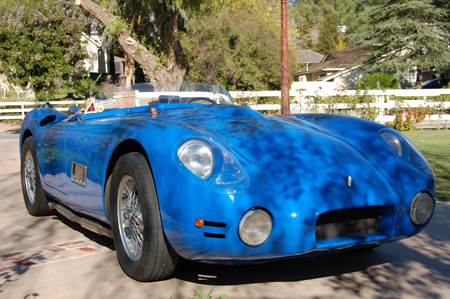
This is a 1957 Talbot “barquette,” now the property of Howard Levy of L.A., CA. Talbot, a prestigious French marque in the pre WWII years, ambled on post-War but was eventually killed off by high taxes levied on large-displacement-engined cars by the socialist French government. Photo © Howard Levy.
|
Still, the 1920’s and 30’s were the most brilliant years of the French automobile industry. Celebrated makers such as Delage, Delahaye, Bugatti and Talbot, along with their coachbuilders produced some of the most gorgeous automobiles ever built. These passionate entrepreneurs were mostly small industrialists, though, with a tiny output and few technological innovations. Meanwhile, thanks to Henry Ford and Billy Durant, America had gone fully to mass production and taken the world’s lead of the automobile industry, way ahead of Renault, Citroën and Peugeot, the largest French manufacturers.
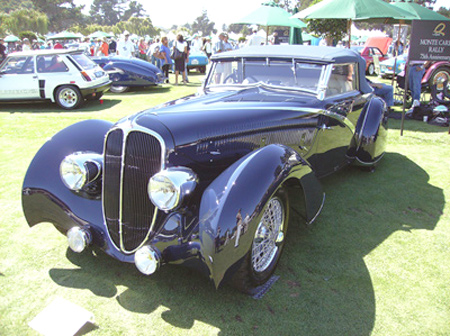
A perfect example of the magnificent pre-WWII French automobiles: the 1936 Delahaye 135 Competition, owned by Ken and Ann Smith in California, here displayed at Quail Lodge in 2007. Photo credit: Brandy Elitch.
|
Of the three major Gallic makers still standing after World War II, (Renault, Peugeot, Citroën), Renault was the first to enter United States with conquest in mind. It was 1956 and the little rear-engined Dauphine--which had just won the Monte Carlo Rally outright-- was their Trojan horse.
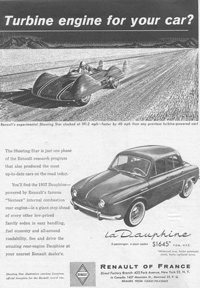
A typical ad for the Renault Dauphine. The car’s sales peaked at less than 70,000 per year in 1959, then evaporated.
|
The Dauphine was at first a great success, almost outselling VW in 1959. Its tiny engine, however, could not stand the strain of riding the U.S. highway system and French customer service, unlike VW, as always, was lousy. Peugeot and Citroën followed Renault in America. The Peugeots were sold by Renault dealers, and Citroën dealers also handled the 40 mpg Panhard. Lack of vision, poor customer service and marketing incompetence resulted in low sales levels. VW held on to the imported car lead and kept it until the Japanese cars were firmly established in the U.S.
Then, in 1979, Renault made a bold move to establish a broad business base in North America: it took a controlling interest in ailing American Motors. The Renault Alliance, an adaptation of a French design, was an early fast seller, with 115,000 sales in 1982. Once again, however, poor quality and service were insurmountable obstacles, especially at a time when Japanese brands were increasing their sales ever higher. Despite some creative vehicles such a Le Car, the French beachhead was never broad nor deep. Peugeot, unable to make an impression with its undistinguished 505 and 405, raised the white flag early in the 1990's. Thus, French makes vanished beneath the sands of America inside of forty years.
As this swift historical perspective shows, however, the French left a highly visible imprint in America’s automotive landscape, but also one quite typical of their character. Great conceptual thinkers and always outstanding with language, they invented the modern layout of the automobile, developed its essential mechanical elements early, then pretty much, with the sole exception of the radial tire invented by Michelin in the 1950’s, confined themselves to contributing a long list of elegant or useful words to our modern automotive industry.
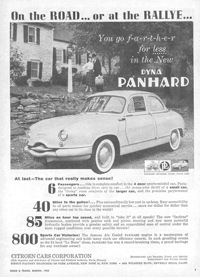
The 850cc-engined Panhard was even less well-suited for the U.S. market. Its similarly powered cousin Deutsch-Bonnet coupé, however, would help revolutionize American car racing.
|
The final apotheosis of this obsession with words took place in the 1980’s when the clashes between the American and French staffs at American Motors over the names of their jointly built cars heated up. The French insisted on names that were understandable both in English and French, regardless of their appeal to American car buyers. The French side won that battle. That gave us the Renault Alliance, then the Renault Encore, then the last name before the final French rout, the Renault Medallion. Perhaps its Cabriolet version would have been called the Renault Filet Mignon.
After that final battle of words, the French had lost the war and their experience in America could be summed up in three words. To paraphrase Julius Caesar, that famous conqueror of Gaul: “Veni, Vidi, Exit” (I came, I saw, I left). So, Mr. Ghosn, we’re waiting for you to bring Renault back here with a winning lineup.
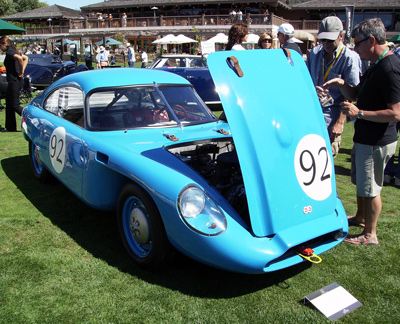
A Panhard-powered 1958 Deutsch-Bonnet coupé, chassis #1057, currently owned by Arthur B. Cook of Pacific Palisades. It is here displayed at Quail Lodge in August, 2007. This car raced in the Sebring Twelve Hours in 1959 and will be the topic of our next article. Photo by Brandy Elitch.
|
Epilogue
Interestingly, vintage French cars have a wide and respected following in America today. The Bugattis, Delages, Delahayes and Talbots are always favorites in prestigious Concours d’Elégance (another French name contribution), but so do increasingly lesser-known marques such as Deutsch-Bonnet, Panhard and Facel Vega. Our next article will feature a very special Deutsch-Bonnet coupé and its extraordinary story tied to Sebring.
|

|